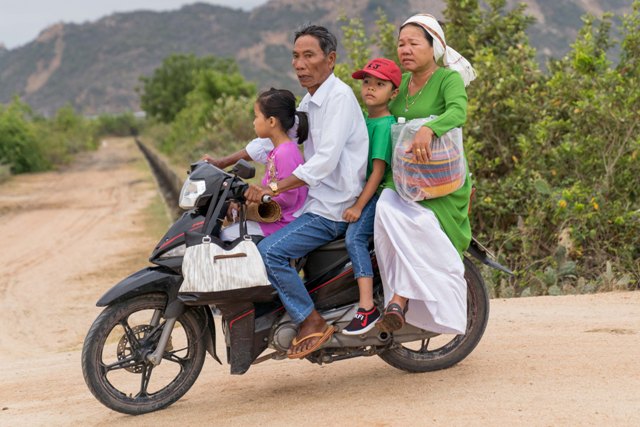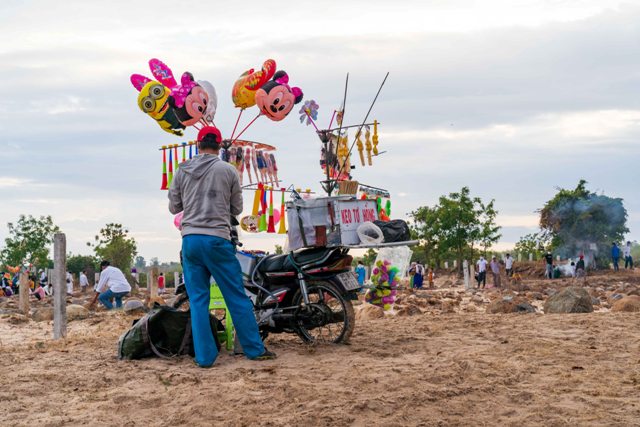Ramuwan is Vietnam’s own Ramadan, for the ethnic Muslim minority Cham people
Experience Ramadan, Vietnam Style
In April I was traveling around Nha Trang, when I heard about Cham New Year starting the next morning near Phan Rang. After a short detour we got to Phan Rang in the late afternoon. Early the next morning we continued to a Cham cemetery in Van Lam village 15km further south. Although quiet at first, suddenly people started to arrive in droves, on motorbikes, old people, couples, whole families and suddenly there were hundreds of Cham people.
Ramuwan, the Cham name for Ramadan, the ninth month of the Islamic calendar, and the month in which the Quran is believed to be revealed to the Islamic prophet Muhammad, is the most important festival in cultural and spiritual life of Bani Muslims, mostly Cham by ethnicity.


The festival takes place in order to protect the traditional cultural values of Cham people, at the same time to educate young generations to live a good life, please the gods and build a strong community. The Ramuwan festival includes many spiritual rites dedicated to the gods and the ancestors. These rites include cleaning and decorating ancestral graves, rice offering, body-purifying and praying at the mosques.
Cham Bani families visit the graves in the clan’s cemeteries. They bring offerings such as betel and areca, fruits, sweets, tobacco and tea. After a year, grass grows thick on the pathways, and the rains and winds almost level the graves and the furrows between them. So the first thing they do is to weed the whole cemetery and heap up the graves with sand to make the rows and columns look neat. A cleric ranked Po Acar splashes holy water on every grave stone. Men who have passed the aia karak ritual sit beside the graves, read prayers and invite the ancestral souls to come for the descendants to pay their respect. Women in white dresses and white Bram shawls pray with them while younger people sprawl on the ground. A family may have to visit graves in many different cemeteries, some of which may be far from their home. But they never omit any of the graves. That is a cultural characteristic of the Cham people, a beautiful gesture to show their gratitude towards their ancestors.


The dead are buried next to each other at the cemetery. There are two stones placed on the ground as the marks of head and feet. It can be seen two lines of stones as all the dead family relatives are buried at the same plot. The lines are separated by other stones at the end of each family section. The lines are directed from East to West.
Early in the morning, hundreds of cham Bani people in their traditional costumes gather at the cemetery. To prepare for worshiping, ladies make a sandy line between each pair of stones. Men arrange offerings, then the Cham priests will come and bless by chanting and pouring holy water on each sandy line. All the members of the family are ready for worshiping, men on the left side and women on the right side.
The worship is finished in the morning and then continued with other celebrations in the main spiritual communal settings and at home.
The Cham are one of 54 uniquely different ethnic groups that make up Viet Nam. They were the dominant ethnic group in Central Vietnam between the 2nd and 15th centuries, interestingly occupying Angkor Wat in the 12th century for 4 years, although today their numbers are less than 100k and they are mostly located in Ninh Thuan, Binh Thuan and parts of the Mekong Delta. You can see their distinct red brick towers throughout central Vietnam in Nha Trang, Quy Nhon, and Mui Ne.


Ramuwan Rituals
Rice Offering
During the month of Ramuwan, each Cham Bani household dedicates a space for the visiting ancestors to rest. It is usually a trestle bed on which they put a few pillows, some betels and areca, a teapot, some fruits and sweets. Before the rice offering ritual, an elder man of the family prays to the family ancestors on behalf of the whole household and invites them to come and share their meal. The sacrificial offerings are very simple, including fish, boiled chicken rice wine, betels and areca, and some rice-based dishes. The offering is conducted by a Po Acar clergyman and a man of the house who has passed the aia karak ritual. The offerings are put in two trays:
– The vegetarian tray includes puddings, rice, sticky rice cake and sakaya cake.
– The non-vegetarian tray includes boiled chicken, rice and other delicacies.
The ancestors, one by one, are invited by name. The ritual may take quite some time if the family has a long list of ancestors. Each invitee is offered one vegetarian and one non-vegetarian dish. Each time, after the dishes are offered, the women and other descendants kow-tow and pray to the ancestor, asking them for good health, good business, peace in the family, happiness and prosperity in life. Having done with all the ancestors, they burn aloe wood and read a prayer to finish the ritual.
The Body Cleansing Rite
Cham people are especially scrupulous about body cleanliness. Humans may not be able to keep their body and soul clean during the whole year. So before entering the mosque, every Cham Bani Muslim must perform the body cleansing ritual to remove all the impurities, bad luck and ailments of the old year in order to be ready to receive the good fortune the new year would bring.
This ritual is performed by an elder person in the family for all other family members. Each family has a tank of water scented with crêpe ginger and aloe wood ready beforehand. In the afternoon of the first day the clergymen come to the mosque to practice fasting, a round of drum beats announces that all Muslims must cleanse their body. Family members in the descending order of age take turns to come to the tank, scoop the water and cleanse their face three times. Body cleansing completed, they are now allowed to come to the mosque to make offerings and pray.
The Fasting of the Po Acar Clergy
Bani Islam is a local religion typical of the Cham people of Ninh Thuan and Binh Thuan provinces. In parallel with Allah, Bani Cham also worship their ancestors. Therefore the fasting of the Cham communities is quite different from that practiced by other Muslims in Southeast Asia and elsewhere. Unlike the other Muslims in the world, all of whom have to observe fasting during the whole month of Ramadan, among the Bani Cham only the clergymen have to practice fasting, and even they themselves have to fast only for the first three days, not for the whole month. After that everybody can eat just like in any other month. This unique feature shows the traces of local culture as it was mixed with the practice of the newer religion of Islam.
During the first 15 days of Ramuwan, the clergymen’s families must not slaughter any living thing and must maintain a peaceful air in relation to others. Starting from the 16th day their lifestyle can return to normal. During the whole month of Ramuwan, the families in the village take turns offering food and other necessities to the clergy. Muslims come from everywhere to visit one another and make offerings to the mosque and the clergy in the form of betels and areca, rice or money.
Thanks to JP Klovstad for sharing his beautiful images with us

